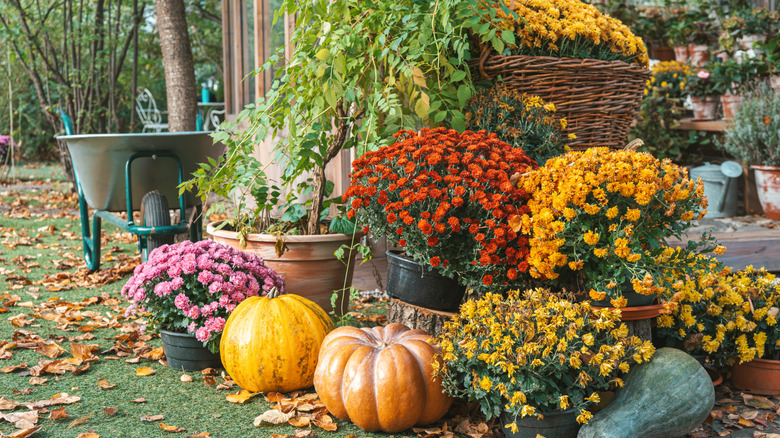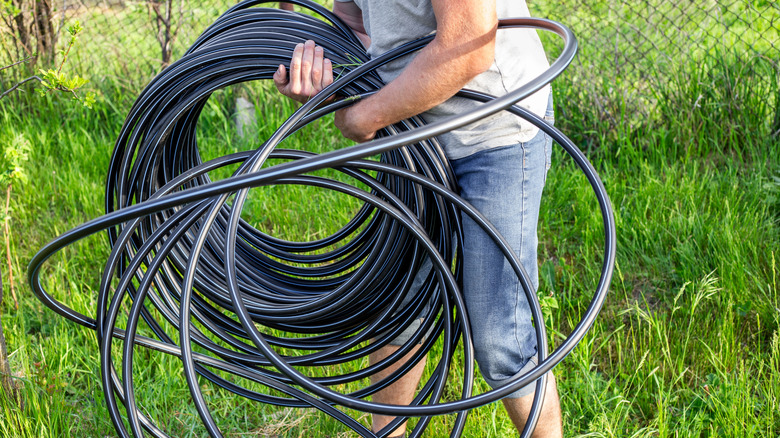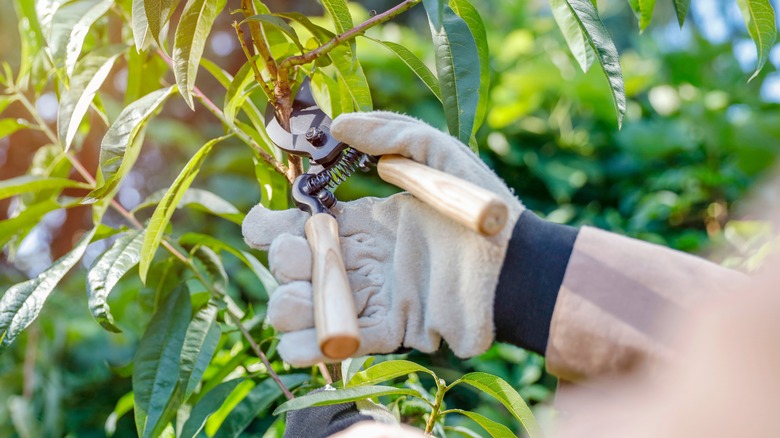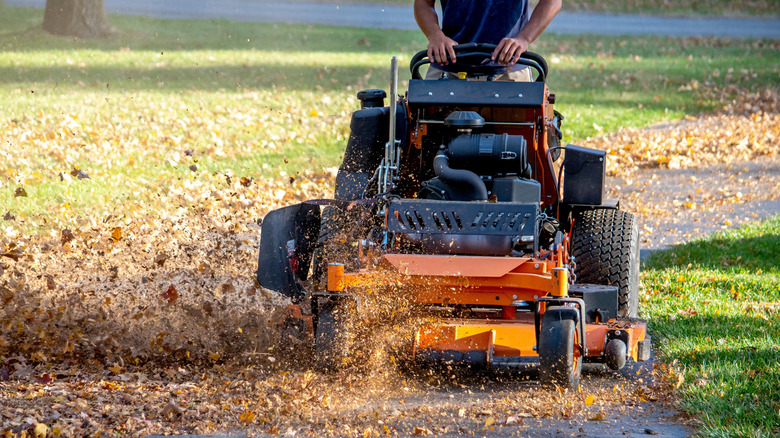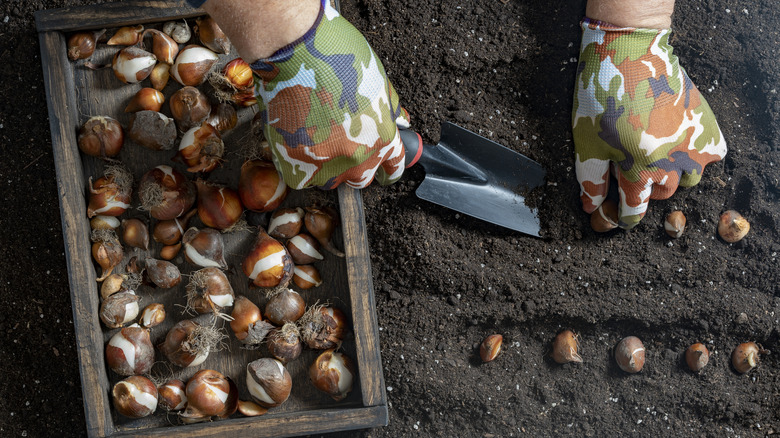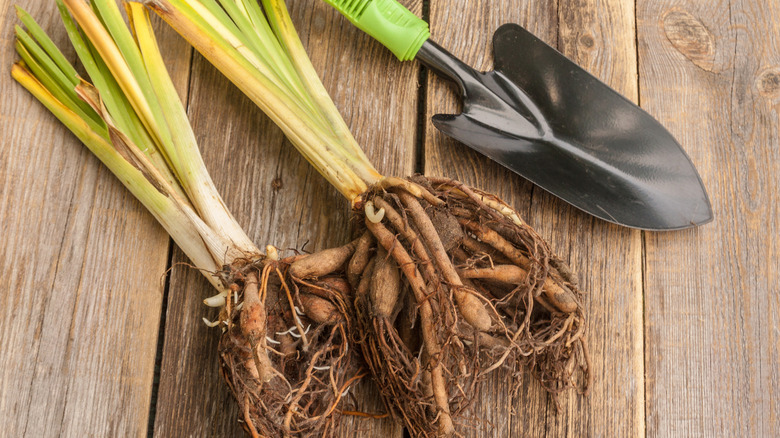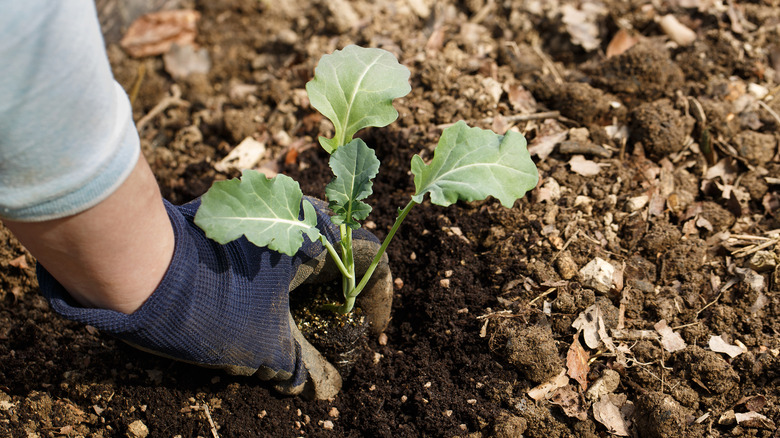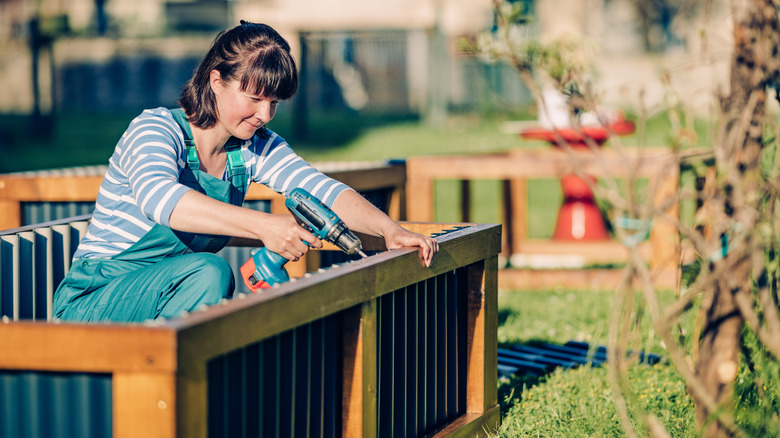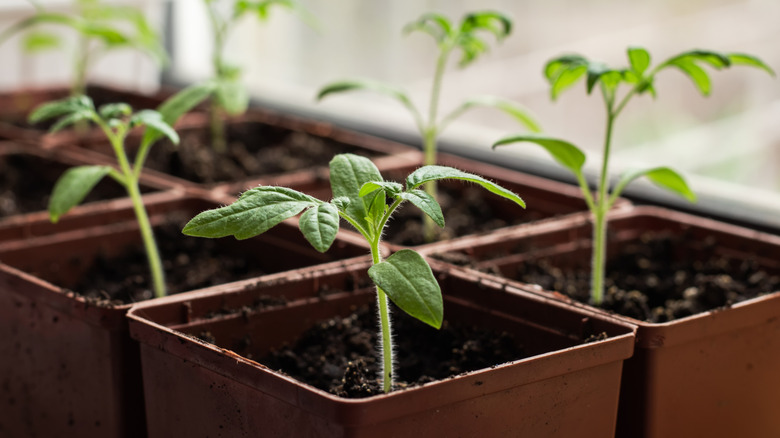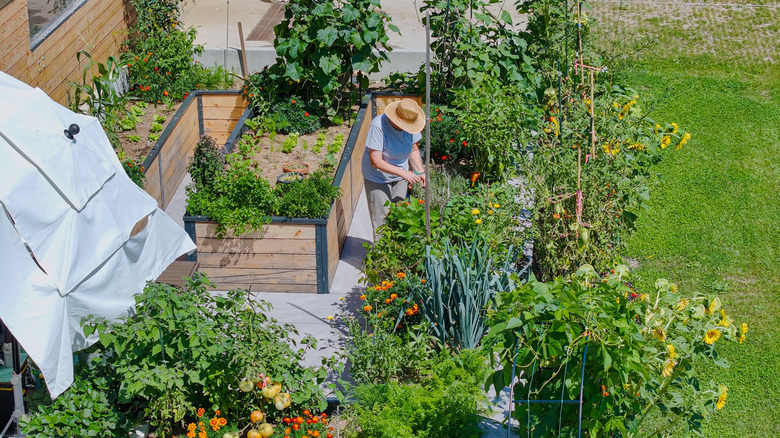Your Fall Garden To-Do List By Growing Zone
Fall is the season most of us associate with winding down and settling in as the air turns crisp and the days become shorter. However, this season can also be one of the most transformative, especially in your garden. As harvesting season comes to an end, you have the opportunity to think back on which of your plants performed their best, the changes you want to make, and other plans, while the successes and struggles of your garden are still fresh. Plus, without the summer heat bearing down, it's a lot easier to work in your garden.
This isn't just a time of reflection, though; there are a lot of tasks you'll want to do now if you want to make the most of the next growing season. Pruning trees, mulching, weeding, and other common chores can be even more important during this time than any other. That said, you'll need to know which USDA hardiness zone you're in before diving into your to-do list. The zone system is based on your area's lowest average temperatures, and most of what you'll plant or prepare in autumn is dictated by the season's first frost. Each region's tasks will look a little bit different month by month, as temperature shifts affect which chores take priority. By making plans according to your zone, you can keep your garden running smoothly throughout every season.
Focus on protecting your garden and its infrastructure in Zones 1 and 2
For those living in Zones 1 and 2, there's a good chance you've already had your first frost toward the end of summer. Because freezing temperatures arrive early in these zones, your most important fall task will be to protect your garden and its features. If you haven't done so already, be sure to put away sprinklers, rain barrels, hoses, irrigation systems, or any other water sources to prevent damage from the expanded frozen water. You'll also want to remove clay or terracotta pots, trellises, frames, and other garden items that could become damaged throughout the wet, cold winter. Store them in a location where they won't be subjected to harsh weather, like a garage or basement.
Just like you want to protect all of your garden structures, it's also important to make sure your plants are prepared for the cold winter ahead. Apply a layer of mulch around perennials that are remaining outside to provide insulation, regulate soil temperatures, and help keep the soil moist. Put up a windbreak around any woody perennials to keep the harsh winds from damaging your plants. One option is a frost cloth, which you can use to cover and protect any plants before an expected freeze. The heavier the cloth, the more insulation it provides, so opt for a more weighted one on exceptionally cold nights. If you've had issues with moose or other animals, you may want to put up a fence.
Do a final garden cleanup before winter hits in Zone 3
Zone 3 gardens will likely have some frosty weather in September, so you'll want to use the milder temperatures to your advantage while you can. In addition to preparing for winter, gardeners in this zone should take some time in early fall to tidy up. Clean out any containers and store them away until the next growing season. If you've had any diseased plants, make sure to remove all the plant parts and dispose of them. Take note of their location so you remember to rotate your crops the following year. Swapping plant families will help prevent pathogens from continuing to build up in the soil.
Even as temperatures drop, there may still be weeds popping up in your yard and garden. Continue pulling them out as they emerge — doing so now will save you time and energy in the spring, as fewer seeds will have the chance to reseed and produce even more once it warms up again. Give your lawn a final mow and mulch any fallen leaves into your lawn for extra nutrients. Continue watering your plants until the first hard freeze, then cover the soil with a layer of mulch, making sure to keep it off the base of your plants. If you want to enjoy spring flowers, plant the bulbs between mid-September and mid-October.
Feed your soil in early October for healthy spring growth in Zone 4
By early October, most Zone 4 gardens will have had at least one frosty night, so start autumn off by cleaning up the garden before the ground freezes. Remove spent flowers and trim away some dying foliage, but don't go crazy cutting back your plants just yet. Instead, wait for late winter to early spring to take care of pruning. While you want to clean up some of the spent flowers in your garden, leave behind healthy seed heads and ornamental grasses. Not only do they add some extra autumn and winter interest, but they also feed birds and other wildlife during the cooler months. Fall is also the best time to dig up tubers that won't survive the winter. Keep them in peat moss until they're ready to plant.
Continue applying organic fertilizers in the fall to give producing plants a boost, while also adding nutrients to the soil for your spring or summer garden. In empty beds, consider growing cover crops to fix nitrogen in the soil, suppress weeds, and help control erosion. Alternatively, mulching in the fall can provide many of the same benefits, later rewarding you with a healthier spring crop. Once you get your first heavy layer of fallen leaves, use a mulching mower to cut them up. The leaves will decompose over winter and naturally fertilize your lawn. That said, if you have cool-season grass, make sure you fertilize your lawn before winter arrives.
Bring houseplants indoors and plant spring bulbs before the ground freezes in Zone 5
Freezing temperatures typically don't hit Zone 5 gardens until mid-October, giving you plenty of time in early fall to work on the typical gardening chores like cleaning pots, weeding, and trimming larger plants. Once the ground temperature is around 55 degrees Fahrenheit or lower, you can start preparing your spring flower garden with daffodil, hyacinth, tulip, and other bulbs. Space the plantings out in weekly intervals until the ground freezes to enjoy a stunning floral display for weeks once winter comes to an end. Once the ground freezes, stop watering any newly planted trees or shrubs and put up hoses and any other water sources.
If you've put your houseplants out to enjoy the sunshine over summer, or have any container plants that won't survive the winter, you'll want to bring them inside once the temperature falls below 45 degrees Fahrenheit. Some tropical species may need to be brought in even earlier. You don't want any pests tagging along and infesting all of your indoor greenery, so make sure to rinse off the leaves and stems and check for any pests. If there are any, you can often use common kitchen ingredients to make a DIY pest control solution. As you near your first frost date, begin storing away tools, taking down water features, and winterizing your garden.
Plant shrubs or trees with fall foliage in Zone 6
A Zone 6 fall offers gardeners weather that isn't too cold or too hot, so enjoy the mild temperatures as you transition between seasons. Continue harvesting any crops and watering your plants until the first frost, which often occurs between mid- and late October. You can plant your spring bulbs up until this point. If you want to surround yourself with pretty fall color as you enjoy the cool breeze outside, start adding some autumn annuals to your beds. You'll also have until November to plant new trees and shrubs, so you can even choose a variety with foliage that turns reds, oranges, and yellows this time of year.
While you'll want to enjoy some relaxing outdoor time during these mild few months, it doesn't mean you don't have some work to do. Continue to pluck any new weeds that emerge from the ground, even after temperatures start to drop. If weeds have been especially pesky, fall is the season to tackle them with a broadleaf weed killer. Persimmons may ripen after a frost, so keep an eye on them once you have a freezing cold night or two. Once you've harvested all of your fall crops, remove spent plants, clean up any plant debris, and begin winterizing your garden. Rake up fallen leaves to use as mulch for your beds, take down hummingbird feeders, and store your hose away.
Dig up and divide perennials in Zone 7
While most other zones will need to move quickly to prepare for winter, Zone 7 gardeners will have some more time to enjoy their backyards. The first frost typically occurs between late October to mid-November, giving you two months of autumn to harvest summer crops and plant a fall garden. Veggies like carrots, kale, peas, and Brussels sprouts can taste even better after a cold spell, so keep harvesting even after a frost. If you're planning on planting a cover crop, do so in early fall to give the seeds enough time to germinate and develop a healthy root system before winter. This is also a good time to begin mulching your beds if you'd prefer to go that route.
In October, you can start planting garlic and onion plants, as well as spring-flowering bulbs. If you have any spring or summer perennials, now is the time to divide them — doing so will prevent them from becoming overcrowded, and you'll get to enjoy extra plants in your garden. Once they're dug up, you can trim the foliage and replant them where you like. Give them a good watering and continue providing moisture until the ground freezes. However, you'll want to wait until winter to apply a layer of mulch, keep an eye on the weather so you're not surprised by a sudden frost. If freezing temperatures are forecasted, empty rain barrels, birdbaths, and drain your hose ahead of time.
Transplant fall vegetable plants in Zone 8
Zone 8 gardeners could get lucky and not see frost until the end of November, though the ground can begin to freeze earlier in the month. So, it's important to stay updated on the weather, so you won't need to face a surprise cold snap. If you've started cool-season vegetable seeds in late summer, you'll be able to start transplanting them sometime in September and October. Don't forget to add some fall-blooming annuals or garden shrubs that flower in the fall. As the season moves into October and November, shift your focus to planting roses and strawberries. Towards the end of fall to early winter, start mapping out your spring flower beds and begin planting daffodils, crocus, hyacinths, and other bulbs.
While your fall garden comes to life, you'll also need to start cleaning up and preparing for winter. Begin trimming any overgrowth on trees or shrubs, and cut back your spring-blooming perennials. Then apply a fresh layer of mulch to release nutrients back into the soil to prepare it for spring. This is also the perfect time to dig up and divide mature plants like peonies. Either hand-pull weeds or apply a pre-emergent to keep weeds from being problematic come spring. Make sure to over-seed cool-season grass lawns before temperatures drop too low, ideally 6 to 8 weeks before frost hits, to ensure they germinate evenly.
Take care of your most demanding garden tasks in Zone 9
With the weather finally cooling down a bit, now is the time to work on demanding garden tasks without the intense heat. If anything needs to be repaired, built, or altered, take advantage of the mild temperatures to get the job done. For example, if you've been wanting to add a raised bed to your backyard, get a head start now, before the weather warms up again. You should also take some time to think over what worked well and what didn't, so you can begin to make any necessary changes for next year. If you're in an area where hurricanes are common, start planning for that as well. Note which containers you'd need to take inside, where you'll store your patio furniture, and make sure your trees and shrubs are pruned properly.
Because Zone 9 gardens won't have the first frost until sometime between late November to mid-December, you'll have plenty of time to grow a flourishing fall garden. In late summer to early fall, think about which vegetables, flowers, trees, and shrubs you want to add to your landscape. Consider the goals you have when designing the layout. For example, if you want to attract more pollinators, make sure to add some nectar-rich flowers to the landscape. Cut back on fertilizing trees and shrubs, but feed crops as needed. If you have any cool-season grass, you can apply fertilizer during this time.
Start your cool-season vegetables in Zone 10
Although frost can sometimes occur in Zone 10, it's incredibly rare, so fall can be one of the best seasons to enjoy your garden. The heat is usually less intense during this time, so some more heat-sensitive crops will be able to thrive in the cooler weather. Additionally, thanks to the lower temperatures, some common pests begin to die back or become far less active. Start your vegetable seeds by early fall so they'll be ready to transplant before nighttime temperatures begin to drop too low. Some easy vegetables to grow from seed include tomatoes, carrots, beans, peppers, spinach, and lettuce. Fruits like melon, cantaloupe, and pumpkin are also great choices for warmer zones. If your flower beds are looking a bit dull, add some color to them by planting wax begonias, nasturtiums, scarlet sage, or other pretty flowering plants that bloom through autumn.
In November, you can start planting bulbs that grow best with cooler soil, like elephant's ear and amaryllis. At this time, you can hold back on watering, as plants don't need as much moisture once the summer heat fades. Turn off any automatic watering systems and only grab the hose when the soil is dry. Make sure to keep up with your usual gardening tasks, like weeding, trimming off dead or diseased stems, and cleaning up any plant debris. Continue mulching throughout autumn, and take out any old mulch and replace it with a fresh layer if needed.
Keep your garden thriving throughout fall in Zone 11 and up
With no frost to worry about, gardeners in Zones 11 and up can enjoy harvesting their crops throughout the entire year. Use autumn as a time to review the progress of your garden to make the next harvest an even better one. In September, you can start most crop seeds that you would've grown earlier in the year, including beans, carrots, tomatoes, onions, and squash. If you dealt with any pests or diseases, it may be a good idea to clean out your garden beds and rotate your crops with each season. As you remove old plants, consider testing the quality of your soil so you can amend it appropriately before sowing any new seeds.
Before revamping your garden, take some time in early fall to reflect on what improvements you can make for an even better harvest. If there were any plants that didn't perform as well as you had hoped they would, see if there is a way to remedy the issue. For example, if certain vegetables wilt in too much heat, you may want to grow them in a shadier area or try to find heat-tolerant varieties. Make any garden changes you've been meaning to tackle, like changing the layout, adding new beds, or attracting more pollinators and other beneficial insects. Review all of your tools, containers, and other gardening items and repair or replace as needed.
